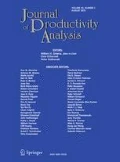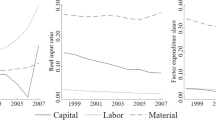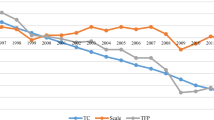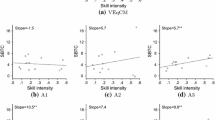Abstract
Technological change and factor bias in the Indian power sector are analyzed using a translog cost function. Various components of technological progress and factor bias are identified and estimated, using a 21 year unbalanced panel data of Indian states and union territories. Heterogeneity across states is incorporated in the model using a variance component model. Appropriate corrections are made for unbalanced panel data. Empirical results show that the annual average rate of technological progress has been 2.4% for the country as a whole. Accumulation of knowledge and increasing scale are found to be the major factors contributing to technological progress. In contrast, the effects of factor price changes and fixed capital accumulation on technological progress have been unfavorable. Pure factor bias measure indicate saving in the use of fuel and labor, and increased use of materials. Tests are performed to check the curvature properties of the underlying technology.
Similar content being viewed by others
References
Ahluwalia, I. J. (1985). Industrial Growth in India, Stagnation Since the Mid-Sixties, Delhi, India: Oxford University Press.
Ahluwalia, I. J. (1991) Productivity and Growth in Indian Manufacturing, Delhi, India: Oxford University Press.
Antle, J. M., and S. M. Capalbo. (1988). “An Introduction to Recent Developments in Production Theory and Productivity Measurement.” In S. M. Capalbo and J. M. Antle (eds.), Agricaltural Productivity Measurement and Explanation, Washington, DC: Resources for the Future.
Baltagi, B. H., and J. M. Griffin. (1988a). “A General Index of Technical Change.” Journal of Political Economy 96, 20-41.
Baltagi, B. H., and J. M. Griffin. (1988b). “A Generalized Error Component Model with Heteroskedastic Disturbances.” International Economic Review 28, 745-753.
Binswanger, H. (1974a). “The Measurement of Technical Change Biases with Many Factors of Production.” American Economic Review 64, 964-978.
Binswanger, H. (1974b). “A Microeconomic Approach to Induced Innovation.” Economic Journal 84, 940-958.
Breusch, T. S., and A. R. Pagan. (1979). “Simple Test for Heterosecdasticity & Random Coefficient Variation.” Econometrica 47, 1287-1294.
Caves, D. W., L. R. Christensen, and M. W. Tretheway. (1984). “Economies of Density versus Economies of Scale: Why Trunk and Local Service Airline Costs Differ.” Rand Journal of Economics 15, 471-489.
Central Statistical Organization. (Various Issues). Annual Survey of Industries. New Delhi: Government of India, Ministry of Planning, Department of Statisties.
Chandok, H. L., and the Policy Group. (1990). India Data Base: The Economy. New Delhi: Living Media India Ltd.
Daly, M. J., and P. S. Rao. (1985). “Productivity, Scale Economies, and Technological Change in Outario Hydro.” Southern Economic Journal 52, 167-180.
Diewert, E. W., and T. J. Wales. (1987). “Flexible Functional Forms and Global Curvature Conditions.” Econometrica 55, 43-68.
Hayami, Y., and V. W. Rutian. (1985). Agricultural Development an International Perspective. Baltimore: Johns Hopkins University Press.
Heshmati, A. (1994). “Estimating Random Effects Production Function Models with Selectivity Bias: An Application to Swedish Crop Product.” Agricultural Economics 11, 171-189.
Hsiao, C. (1986). Analysis of Panel Data. New York: Cambridge University Press.
Jha, R., M. N. Murty, S. Paul, and B. B. Rao. (1993). “An Analysis of Technological Change, Factor Substitution and Economies of Scale in Manufacturing Industries in India.” Applied Economics 25, 1337-1343.
Kmenta, J. (1986). Elements of Econometrics (2nd edition). New York: Macmillan Publishing Company.
Kumbhakar, S. C., and A. Bhattacharyya. (1995). “Productivity in Indian Passenger-Bus Transportation: An Unbalanced Panel Data Approach.” Mimeo, Department of Economics, University of Texas, Austin.
Kumbhakar, S. C., and A. Heshmati. (1996). “Technical Change and Total Factor Productivity Growth in Swedish Manufacturing Industries.” Econometric Reviews 15, 275-298.
Pachauri, R. K. (1977). Energy and Economic Development in India. New York: Praeger Publishers.
Sosin, K., and L. Fairchild. (1984). “Nonhomotheticity and Technological Bias in Production.” Review of Economics and Statistics 66, 44-50.
Stevenson, R. (1980). “Measuring Technological Bias.” American Economic Review 70, 162-173
Wylie, P. J. (1990). “Scale-Biased Technological Development in Canada's Industrialization, 1900–1929.” Review of Economics and Statistics 72, 219-227.
Author information
Authors and Affiliations
Rights and permissions
About this article
Cite this article
Bhattacharyya, A., Bhattacharyya, A. & Mitra, K. Decomposition of Technological Change and Factor Bias in Indian Power Sector: An Unbalanced Panel Data Approach. Journal of Productivity Analysis 8, 35–52 (1997). https://doi.org/10.1023/A:1007720330754
Issue Date:
DOI: https://doi.org/10.1023/A:1007720330754




